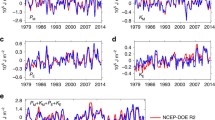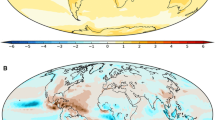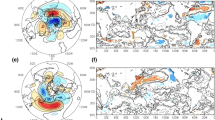Abstract
The energy cycle characterizes basic aspects of the physical behaviour of the climate system. Terms in the energy cycle involve first and second order climate statistics (means, variances, covariances) and the intercomparison of energetic quantities offers physically motivated “second order” insight into model and system behaviour. The energy cycle components of 12 models participating in AMIP2 are calculated, intercompared and assessed against results based on NCEP and ERA reanalyses. In general, models simulate a modestly too vigorous energy cycle and the contributions to and reasons for this are investigated. The results suggest that excessive generation of zonal available potential energy is an important driver of the overactive energy cycle through “generation push” while excessive dissipation of eddy kinetic energy in models is implicated through “dissipation pull‘’. The study shows that “ensemble model” results are best or among the best in the comparison of energy cycle quantities with reanalysis-based values. Thus ensemble approaches are apparently “best” not only for the simulation of 1st order climate statistics as in Lambert and Boer (Clim Dyn 17:83–106, 2001) but also for the higher order climate quantities entering the energy cycle.









Similar content being viewed by others
References
Boer GJ (1982) Diagnostic equations in isobaric coordinates. Mon Wea Rev 110:1801–1820
Boer GJ (2000a) Analysis and verification of model climate, chap 3. Numerical modelling of the Global Atmosphere, NATO Science Series. Kluwer, Dordrecht, pp 59–82
Boer GJ (2000b) Climate model intercomparison, chap 19. Numerical modelling of the Global Atmosphere, NATO Science Series. Kluwer, Dordrecht, pp 443–464
Boer GJ, Lambert SJ (2001) Second-order space-time climate difference statistics. Climate Dyn 17:213–218
Boer GJ (2003) Multi-model ensemble long-timescale potential predictability. In: Proceedings of the 18th stanstead seminar, Lennoxville, 16–20 June 2003
Boer GJ, Arpe K, Blackburn M, Déqué M, Gates WL, Hart TL, le Treut H, Roeckner E, Sheinin DA, Simmonds I, Smith RNB, Tokioka T, Wetherald RT, Williamson D (1992) Some results from an intercomparison of climates simulated by 14 atmospheric general circulation models. J Geophys Res 97:12771–12786
Gates WL (1987) Problems and prospects in climate modeling. In: Radok U (ed) Toward understanding climate change. Westview Press, Boulder, pp 5–34
Gates WL (1992) AMIP: the Atmospheric Model Intercomparison Project. Bull Am Meteor Soc 73:1962–1970
Gates WL, Boyle JS, Covey C, Dease CG, Doutriaux CM, Drach RS, Fiorino M, Gleckler PJ, Hnilo JJ, Marlais SM, Phillips TJ, Potter GL, Santer BD, Sperber KR, Taylor KE, Williams DN (1999) An overview of the results of the Atmospheric Model Intercomparison Project (AMIP). Bull Am Meteor Soc 80:29–56
Kalnay E, Kanamitsu M, Kistler R, Collins W, Deaven D, Gandin L, Iredell M, Saha S, White G, Woollen J, Zhu Y, Leetmaa A, Reynolds B, Chelliah M, Ebisuzaki W, Higgins W, Janowiak J, Mo KC, Ropelewski C, Wang J, Roy Jenne, Dennis Joseph (1996) The NCEP/NCAR 40-year reanalysis project. Bull Am Meteor Soc 77:437–471
Lambert SJ, Boer GJ (2001) CMIP1 evaluation and intercomparison of coupled climate models. Clim Dyn 17:83–106
Lorenz EN (1955) Available potential energy and the maintenance of the general circulation. Tellus 7:157–167
Peixoto JP, Oort A (1992) Physics of climate. American Institute of Physics, New York, 520 pp
Taylor KE (2001) Summarizing multiple aspects of model performance in single diagram. J Geophys Res 106:7183–7192
Uppala SM, Kållberg PW, Simmons AJ, Andrae U, da Costa Bechtold V, Fiorino M, Gibson JK, Haseler J, Hernandez A, Kelly GA, Li X, Onogi K, Saarinen S, Sokka N, Allan RP, Andersson E, Arpe K, Balmaseda MA, Beljaars ACM, van de Berg L, Bidlot J, Bormann N, Caires S, Chevallier F, Dethof A, Dragosavac M, Fisher M, Fuentes M, Hagemann S, Hólm E, Hoskins BJ, Isaksen L, Janssen PAEM, Jenne R, McNally AP, Mahfouf J-F, Morcrette J-J, Rayner NA, Saunders RW, Simon P, Sterl A, Trenberth KE, Untch A, Vasiljevic D, Viterbo P, Woollen J (2005) The ERA-40 re-analysis. Q J R Meteorol Soc 131:2961–3012. doi:10.1256/ qj.04.176
Acknowledgments
The model data was obtained from PCMDI as part of the AMIP2 intercomparison project. We appreciate the comments of J. Fyfe and G. Flato on an earlier version of the manuscript.
Author information
Authors and Affiliations
Corresponding author
Appendix
Appendix
1.1 Energy cycle terms
The energy cycle equations used in this investigation are given by (4) and we list here the expressions used for calculating the terms in (4). Boundary conditions in pressure coordinates are incorporated by means of the β function \(\beta(\lambda, \varphi, p, t)=\left\{\begin{array}{l}1,\quad p < p_{s}\\0, \quad p > p_{s}\end{array}\right.\) following Boer (1982). Reanalysis and model data are given on pressure surfaces and values which are “underground” (i.e. for which p s < p) are filled by interpolation. The approach used here masks out these unphysical values in a consistent way so that they do not enter the calculation.
The general energetic equations consider the decomposition of into zonal, standing eddy and transient eddy components as in Table 1 but taking theβ term into account as
Available potential and kinetic energy are
but, as mentioned in the text, a number of terms involving the stationary eddy components are not available in the AMIP2 data set. For this reason among others, the stationary and transient eddy components are considered together in a combined eddy term.
The components of the available potential and kinetic energy become
and the generation of available potential energy and the dissipation of kinetic energy is
The conversion between available potential and kinetic energy is
that between zonal and eddy available potential energy is
and that between zonal and eddy kinetic energy is
The symbols have their usual meteorological meanings and the integration is over the mass of the atmosphere. Terms are calculated on a monthly basis, that is, the means are monthly means and the variances and covariances are calculated from the synoptic variability about these monthly means.
1.2 Multi-model quantities
The ensemble model value of any of an energy budget terms, say C, is simply the ensemble mean {C} over all model values. These results are labelled MBUD in the diagrams. The mean model value, on the other hand uses the ensemble mean of the model statistics entering the calculation of C and the result is labelled MMOD in the diagrams. Symbolically if \(C=f(\overline{x},\overline{y},\overline{x_{E}y_{E}},\ldots)\) represents the calculation of an energetic quantity C, the “ensemble model” value is \(\{C\}=\{f(\overline{x},\overline{y},\overline{x_{E}y_{E}},\ldots)\},\) where {X} is model ensemble mean, while the “mean model” value is calculated from the ensemble average of the model values/statistics themselves, i.e. as \(C_{m}=f(\{\overline{x}\}, \{\overline{y}\}, \{\overline{x_{E} y_{E}}\}, \ldots).\)
Rights and permissions
About this article
Cite this article
Boer, G.J., Lambert, S. The energy cycle in atmospheric models. Clim Dyn 30, 371–390 (2008). https://doi.org/10.1007/s00382-007-0303-4
Received:
Accepted:
Published:
Issue Date:
DOI: https://doi.org/10.1007/s00382-007-0303-4




